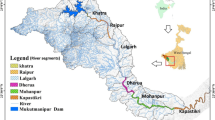Abstract
With the rapid socio-economic development, a series of functional decline of river system has emerged, such as water pollution, environmental degradation and river shrinkage. The health of ecological river and its comprehensive management has become a hot topic in many countries and regions. Based on the combined influence of various factors, the multiple index system of river health assessment in the upstream of Hun River is established by Driving Forces-Pressure-State-Impact-Responses Model, the evaluation of river health is calculated by the Variable Fuzzy Assessment. The result shows that the river health assessment value is 2.944, which belongs to the weak state of sub health. And given this existence of the research section is located in the upstream of Hun River, carrying a remarkable ecological service potential. Therefore, it is of significant importance to protect, improve and repair the river ecological environment.
Similar content being viewed by others
References
Norris, R.H. and Thoms, M.C., What is river health?, Freshwater Biology, 1999, vol. 41, pp. 197–209.
Boulton, A.J., An overview of river health assessment: philosophies, practice, problems and prognosis, Freshwater Biology, 1999, vol. 41, pp. 469–479.
Karr, J.R., Fausch, K.D., et al., Assessing biological integrity in running water: a method and its rationale, in Illinois Natural History Survey, Champaign, IL, Special Publication 5, 1986.
Karr, J.R., Defining and measuring river health, Freshwater Biology, 1999, vol. 41, pp. 221–234.
Lorenz, C.M., Van Dijk, G.M., et al., Concepts in river ecology: implications for indicator development, Regulated Rivers: Research and Management, 1997, vol. 13, no. 6, pp. 501–516.
Mooney, C. and Farrier, D., A micro case study of the legal and administrative arrangements for river health in the Kangaroo River (NSW), Water Science and Technology, 2002, vol. 45, no. 11, pp. 161–168.
Thorp, J.H., Thoms, M.C., and Delong, M.D., The riverine ecosystem synthesis: biocomplexity in river networks across space and time, River Research and Application, 2006, vol. 22, no. 2, pp. 123–147.
Young, R.G., Matthaei, C.D., and Townsend, C.R., Organic matter breakdown and ecosystem metabolism: functional indicators for assessing river ecosystem health, J. North American Benthological Society, 2008, vol. 27, no. 3, pp. 605–625.
Cary, J. and Pisarski, A., Social benchmarking to improve river ecosystems, Water Science and Technology, 2011, vol. 64, no. 5, pp. 1148–1153.
Zhao, Y.W. and Yang, Z.F., Integrative fuzzy hierarchical model for river health assessment: A case study of Yong River in Ningbo City, China, Communications in Nonlinear Science and Numerical Simulation, 2009, vol. 14, pp. 1729–1736.
Ness, B., Anderberg, S., and Olsson, L., Structuring problems in sustainability science: the multi-level DPSIR framework, Geoforum, 2010, vol. 41, pp. 479–488.
Chen, S.Y. and Hu, J.M., Variable fuzzy assessment method and its application in assessing water resources carrying capacity (in Chinese), J. Hydraulic Engineering, 2006, vol. 37, no. 3, pp. 264–271.
Chen, S.Y., Theory and Model of Variable Fuzzy Sets and Its Application (in Chinese), Dalian University of Technology Press, 2009.
Jia, Q., Qiu, L., Duan, C.Q., and Chen X.N., Application of assessment model based on variable fuzzy set in water resources carrying capacity in Taohe River basin, Intern. Conf. Intelligent Computation Technology and Automation, 2010, pp. 730–732.
Geng, L.H., Liu, H., Zhong, H. P., and Liu, C.S., Indicators and criteria for evaluation of healthy rivers (in Chinese), J. Hydraulic Engineering, 2006, vol. 37, no. 3, pp. 253–258.
Liu, C.M. and Liu, X.Y., Healthy river and its indication, criteria and standards, J. Geographical Sciences, 2009, vol. 19, pp. 3–11.
Lü, S.B., Xu, S.G, Ma, T., and Guo C.L., Application of variable fuzzy recognition model in comprehensive benefit evaluation of floodwater utilization, in Seventh Intern. Conf. Fuzzy Systems and Knowledge Discovery, 2010, pp. 836–840.
Chen, S.Y. and Fu, G.T. Combining fuzzy iteration model with dynamic programming to solve multi objective multistage decision making problems, Fuzzy Sets and Systems, 2005, vol. 152, pp. 499–512.
Hu, X.X., Yang, X.H., Li, J.Q., and Geng, L.H., Set pair analysis model for river health system assessment (in Chinese), Systems Engineering—Theory and Practice, 2008, no. 5, pp. 164–170.
Shen, Y.P., Case study on assessment of urban river ecosystem health, Meteorological and Environmental Sciences, 2008, vol. 31, no. 2, pp. 13–16.
Schofield, N.J. and Davies, P.E., Measuring the health of our rivers, Water, 1996, May/June, pp. 39–43.
Author information
Authors and Affiliations
Corresponding author
Additional information
The article is published in the original.
Rights and permissions
About this article
Cite this article
Xu, S., Liu, Y. Assessment for river health based on variable fuzzy set theory. Water Resour 41, 218–224 (2014). https://doi.org/10.1134/S0097807814020134
Received:
Published:
Issue Date:
DOI: https://doi.org/10.1134/S0097807814020134




